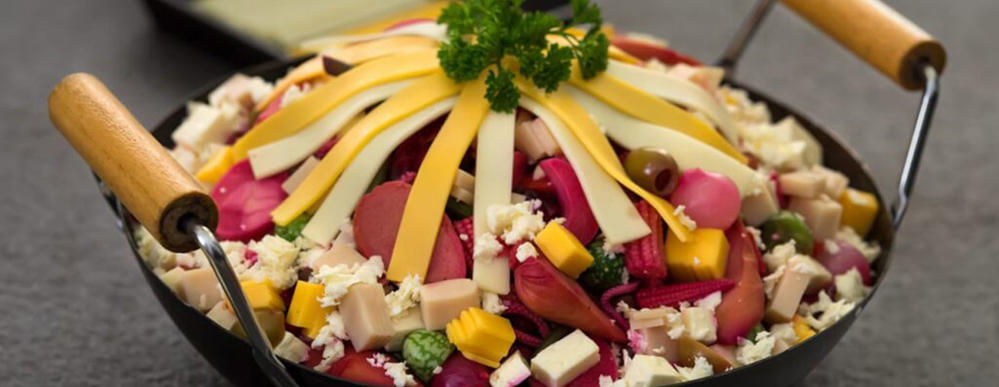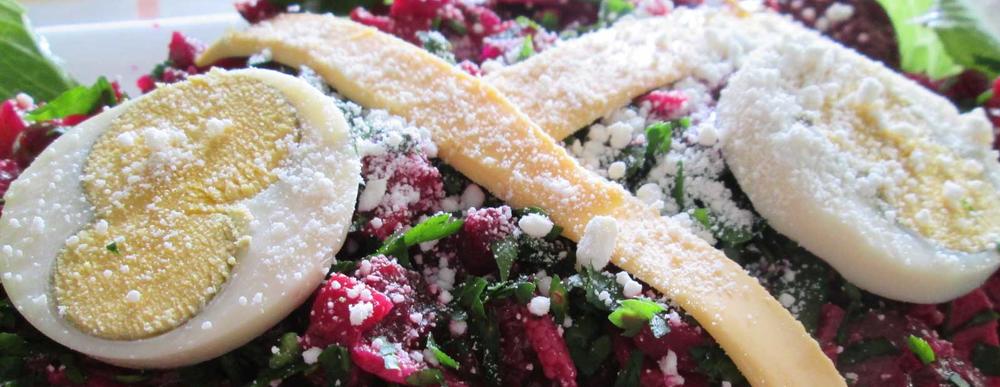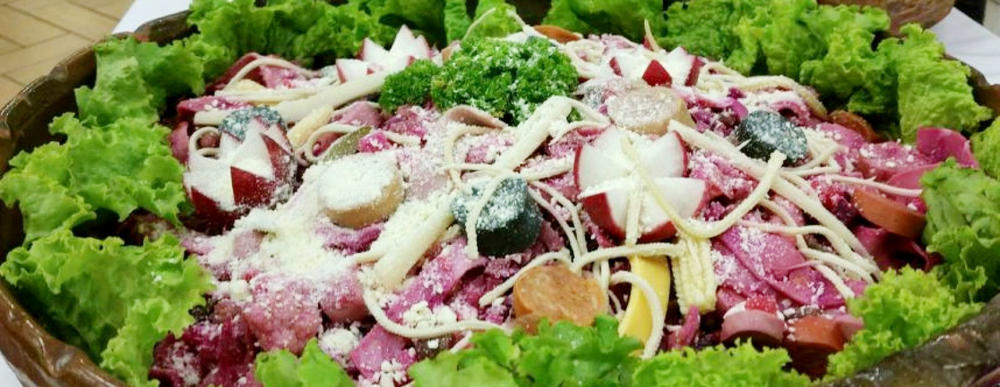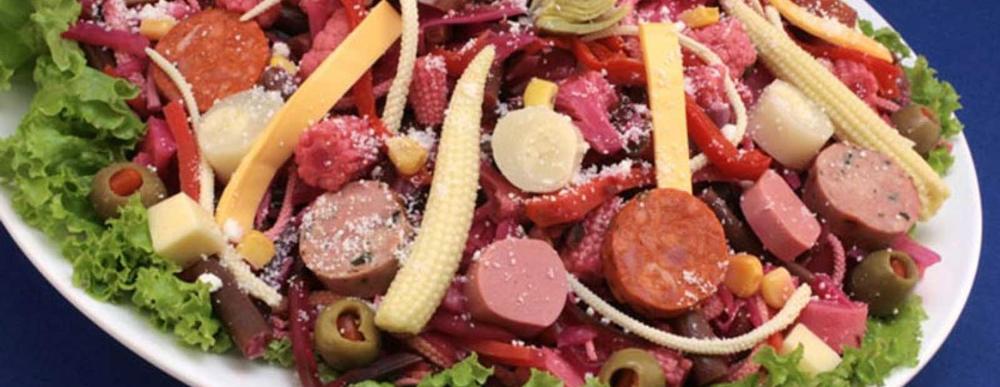Posted on Oct 08, 2018 |
The popular Guatemala dish we all enjoy every year on November 1st, which is ‘All Saints Day’ (El Día de Todos Los Santos), a day before the ‘Dia de Los Muertos’. Some say that this dish is an offering for a particular date of the year. But the history tell us the real origin of this popular Guatemalan dish and recipe.
A custom that began a few centuries ago, when families and friends share in a private celebration on November 1st the All Saints Day (Día de Todos Los Santos), Fiambre is a offering to all Saints on that day. Several countries in Latin America celebrate the All Saints’ Day, but Fiambre is unique to Guatemala.
On November 2nd (Día de Los Muertos), Guatemalan families visit cemeteries and gravesites to remember their loved departed ones bringing flowers, fruits and incense, a strong Guatemalan tradition.
Two traditions celebrated together in Guatemala, and yet both traditional cultural events are different. Fiambre is only celebrated only on November 1st, and historically corresponds only to this date, All Saints' Day.
No Fiambre recipe is the same, each family has a different recipe passed from generation from generation, and represents a blend or mixture not only of typical Guatemalan ingredients, but also of cultures, for it combines ingredients and techniques of the pre-Hispanic cuisine of Guatemala such as fresh vegetables with meats and sausages that are the influence of Spanish cuisine. Some recipes also conserve ingredients such as capers, olives and some dressings that are Arabic influences brought by the Spanish.
Fiambre must be accompanied by a traditional Guatemalan dessert, which is Dulce de Ayote and Jocotes en Miel.
Tell the Story
There are a few theories about the origin of Fiambre, but there are some written data that suggest that it emerged around 1770. Tell the story that after a series of natural disasters in Guatemala causing food shortages, a Spanish commission visited Guatemala staying at the home of a important Spanish family . The chef (or the cook), not having any dish to offer due to the shortages, decided to make a cold mixture of available ingredients that were left over in the kitchen. A dish that the guests really liked.
This anecdote and recipe spread throughout the city and families began to adopt this recipe to become a traditional Guatemalan dish.
Fiambre is basically a cold salad, it has an average of 40 ingredients, including vegetables, meats, pork, chicken, even shrimp and cheese of different kinds. Technically the recipe is simple, but its preparation takes time and should be done at least a couple of days before serving as it has to be marinated in a sauce of vinegar and mustard. It brings the family member together to contribute and help in the kitchen for this dish. Due to the mixture of so many ingredients, the final dish is very abundant. The family will continue eating this dish for several days.
El Fiambre is a very natural and nutritious recipe.
The Recipe
There are two kinds of Fiambre and the only difference is basically one ingredient; the Fiambre Rojo (Red one) is made with beets in it, Fiambre Blanco (White Fiambre) is made without beets. Just like mentioned before, each family has a different recipe, some add more or less ingredients. We will include a good average number of ingredients for you to make your own.

Ingredients
Please note that some additional ingredients will be included in the instructions below, suchs as vinager and others.
Vegetable
- 3 cups chopped green beans
- 6 medium size beets
- 1 medium size cauliflower
- 1 cup of peas
- 1 chamborote chili to decorate or pepper
- 1 lettuce to garnish
- 3 cups dry cheese
- 6 pacayas (cooked and chopped)
- 3 cups chopped carrot
- 3/4 cup of celery
- 1 medium size cabbage (chopped)
- 4 ounces of craft cheese
- 4 ounces mozzarella cheese
- 4 hard boiled eggs
- 1 cup of brussels sprouts
- 2 ears corn husked or canned
- 1 can of asparagus
- 4 ounces of olives
- 2 ounces of capers
- 1 can of red pepper
- 1 jar of pickled onions
Sausages
- 4 black sausages
- 4 red sausages
- 4 sausages (butiffarras)
- 3 smoked sausages
- 4 sausages from Extremadura
- 4 sausages (longanizas)
- 4 ounces of ham
- 4 German sausages
Meats
- 2 pounds of chicken meat (cooked and cut into small pieces)
- 1 pound of pork carn (cooked and cut into small pieces)
- 1 pound beef meat (cooked and cut into small pieces)
- 1/2 pound of roast beef (chopped in small pieces)
Seafood
- 1 can of sardines in olive oil
- 1 can mussels
- 1 1/2 cup of small shrimp
Process and Preparation
You should start with this process 3 days in advance. Cook cauliflower, brussels sprouts, cabbage, pacaya and green beans and peas, seasoned with a little salt and pepper for 10 minutes, drain and let cool. Remember to cook the beets separately, boil the beets until just cooked, but still firm. Cook the chicken and meats with parsley adding salt and pepper to your taste. Cut the cooked chicken and meats into small pieces and store it. Keep the broth to later use it.
Two days before serving, mix all the ingredients in large glass container, set the beet aside. Mix the broth with vinegar, olive oil, mustard, thyme, oregano, three bay leaves, salt and pepper, add spices to taste. Simmer for a few minutes and then chill, and mix all vegetables with beets, store in the refrigerator overnight.
In a pan, cook all the sausages, and then cut them into slices and let them cool. Then, combine all the sausages with the meats in a large bowl and mix them well all together, then store it in the refrigerator overnight.
Leave some meat to decorate separately, do the same with some sausages and sardines, these will be used at the end only as an garnish.
One day before serving, mix the meats, sausages and vegetables in a large enough glass or container. Allow all ingredients to tan during the night in the refrigerator. Mixing several times is recommended.
The next day (November 1st) Fiambre is ready, decorating the plate of each diner with lettuce, meats (reserved for this purpose ) and cheese. Finally, place egg and parsley as the final touch to the dish.
ENJOY !!!
Note : As a healthy recommendation, we would like to suggest you to use organic and natural products to prepare your recipes. If you are in Guatemala, ask in Spanish: productos organicos guatemala .
Latest Posts
-
Easter Week 2025 Schedule Processions Antigua Guatemala
- Mar 02, 2025 -
Ten Beautiful Words in the Spanish Language
- Jul 13, 2024 -
Easter Week 2024 in Antigua Guatemala
- Feb 04, 2024



